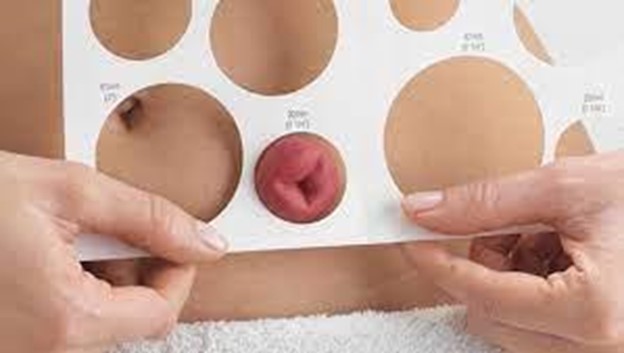A nurse is providing teaching to a client who has a new colostomy. Which of the following actions should the nurse take when demonstrating how to change the ostomy appliance?
Apply the skin sealant on damp skin.
Remove the appliance before emptying the pouch.
Ensure that the skin is slightly damp for better adhesion of the pouch.
Trace the size of stoma onto the skin barrier.
The Correct Answer is D
Choice A rationale:
Apply the skin sealant on damp skin. Rationale: Applying skin sealant on damp skin is not the recommended approach for securing an ostomy appliance. It's important to ensure that the skin is clean and dry before applying the sealant or the skin barrier. Moisture can compromise adhesion and lead to skin irritation or appliance detachment.
Choice B rationale:
Remove the appliance before emptying the pouch. Rationale: Removing the appliance before emptying the pouch is not a necessary step when changing an ostomy appliance. Typically, the pouch can be emptied without removing the entire appliance, which helps maintain the seal and reduces unnecessary skin exposure.
Choice C rationale:
Ensure that the skin is slightly damp for better adhesion of the pouch. Rationale: Ensuring that the skin is slightly damp is not advisable for better adhesion of the pouch. The skin should be completely dry before applying the pouch to ensure proper adhesion. Moisture on the skin can lead to leakage or detachment of the appliance.
Choice D rationale:
Trace the size of stoma onto the skin barrier. Rationale: This choice is the correct answer because tracing the size of the stoma onto the skin barrier ensures a precise fit, which is crucial for preventing leaks and maintaining the integrity of the ostomy. A proper fit also helps in preventing skin irritation and discomfort. Choosing the correct barrier size based on the stoma's dimensions is a key aspect of effective ostomy care.

Nursing Test Bank
Naxlex Comprehensive Predictor Exams
Related Questions
Correct Answer is A
Explanation
Choice A rationale:
Before initiating teaching for a client with a new diagnosis of type 2 diabetes mellitus, it is essential to identify the client's learning needs. This involves assessing what the client already knows about the condition, their level of understanding, and any specific areas of concern or interest. By establishing the learning needs, the nurse can tailor the teaching plan to address the client's individual requirements, thereby enhancing the effectiveness of the education provided.
Choice B rationale:
While determining the client's literacy level (Choice B) is important, it might not take precedence over understanding the client's learning needs. However, assessing literacy is still relevant because it helps the nurse adapt the teaching materials and language used to ensure the client comprehends the information.
Choice C rationale:
Evaluating the client's readiness for learning (Choice C) is significant, but it should ideally follow the identification of learning needs. Readiness for learning pertains to the client's emotional and psychological state, which can impact their ability to absorb new information. While essential, it should not be the initial step in planning teaching.
Choice D rationale:
Verifying the client's computer access (Choice D) is not directly related to the immediate planning of teaching for a new diagnosis of type 2 diabetes mellitus. While technology and access to online resources can enhance learning, this consideration is secondary to understanding the client's knowledge gaps and preferred learning style.
Choice E rationale:
Identifying the client's learning style (Choice E) is valuable in customizing the teaching approach, but it comes after establishing learning needs. Learning styles, such as visual, auditory, or kinesthetic, can influence the most effective way to present information. However, without first determining what the client needs to know, tailoring the teaching style might not yield optimal results.
Correct Answer is A
Explanation
Choice A rationale:
Teaching the most crucial content early in the session is an effective strategy to engage learners and ensure that they receive essential information. This approach captures their attention and provides a solid foundation for the rest of the session. It helps establish relevance and interest, keeping the learners engaged throughout the educational program.
Choice B rationale:
Assuming that learners have no prior knowledge of first aid might not be the best approach. Adult learners often come with varying levels of knowledge and experience. It's important to assess the learners' prior knowledge and adjust the content accordingly to avoid redundancy or information that is too basic for them.
Choice C rationale:
Repetition of procedures and techniques is a valuable teaching strategy. Repetition aids in retention and comprehension. Reiterating important points reinforces learning and helps participants remember critical steps in first aid procedures. Avoiding repetition can lead to incomplete understanding and retention.
Choice D rationale:
Dividing the planned program into several sessions held about 1 week apart might not be the most effective strategy for community education. Spacing the sessions too far apart could result in learners forgetting the content or losing interest. It's better to maintain a consistent schedule to ensure continuity and engagement.
Whether you are a student looking to ace your exams or a practicing nurse seeking to enhance your expertise , our nursing education contents will empower you with the confidence and competence to make a difference in the lives of patients and become a respected leader in the healthcare field.
Visit Naxlex, invest in your future and unlock endless possibilities with our unparalleled nursing education contents today
Report Wrong Answer on the Current Question
Do you disagree with the answer? If yes, what is your expected answer? Explain.
Kindly be descriptive with the issue you are facing.
